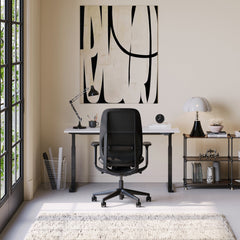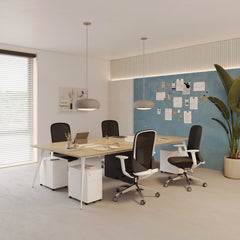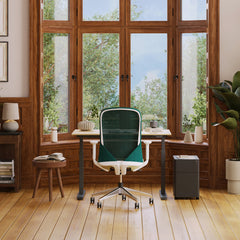Get 10% off your first order
Find the office furniture that’s designed to match your style, comfort, and needs perfectly. Subscribe
Beyond Desks and Chairs: How Cohesive Design Shapes Your Office Brand

Visit quiz page to see how we makes it easy to create an inspiring workplace


When you think about workspace design, it’s easy to focus on furniture shape or layout. But what you touch and see every day—the materials, textures, and finishes—has just as much impact on your mindset.
The warmth of wood, the cool of metal, or the softness of fabric can completely change how you feel when you sit down to work. These choices define not only the visual tone of your workspace but also how it influences your energy, calm, and focus throughout the day. Let’s explore how material and texture create a more balanced, inspiring workspace.
Your sense of touch affects mood and comfort as much as lighting or color. Smooth materials can make a space feel efficient and minimal, while soft textures add warmth and calm.
|
Texture Type |
Emotional Impact |
Best Used For |
|
Smooth surfaces |
Clarity and focus |
Desktops and tech zones |
|
Natural wood |
Comfort and grounding |
Tables and shelving |
|
Fabric |
Warmth and coziness |
Seating or accent panels |
|
Matte finishes |
Calm and simplicity |
Wall or accessory design |
The right mix of textures brings both balance and personality to your workspace.
Combining organic and modern materials creates a workspace that feels alive yet structured. The natural grain of wood can balance the sharp lines of metal or glass.
Pair wood tabletops with metal legs for visual contrast.
Add fabric or cork boards to soften modern setups.
Use neutral materials as a foundation, then add accent textures.
Keep a 70/30 balance between functional and decorative finishes.
A functional, adjustable setup like the Small Standing Desk Ohio allows both natural and modern materials to blend effortlessly while supporting healthy movement.
Color embedded in materials shapes energy levels. Bright whites and cool metals spark clarity, while warm tones and natural wood foster comfort and calm.
|
Color |
Mood |
Material Pair |
|
White |
Fresh, open |
Metal or glass |
|
Beige |
Calm, natural |
Wood or linen |
|
Gray |
Neutral focus |
Concrete or matte paint |
|
Brown |
Cozy and grounded |
Wood and leather |
Choosing complementary tones keeps your workspace harmonious and energizing without overwhelming the senses.
The materials you rest your hands and arms on impact comfort. Hard, cold surfaces can limit movement, while smooth or cushioned textures encourage ease and flexibility.
A height-adjustable standing desk supports this balance, allowing movement while maintaining tactile comfort.
Keep edges rounded to prevent wrist strain.
Choose a surface that feels pleasant to touch for long periods.
Use soft mats or pads for standing areas.
Balance firmness and texture for comfort and precision.
A comfortable workspace keeps both mind and body aligned.
Different materials absorb or reflect sound in ways that affect focus. Hard surfaces amplify noise, while soft materials like fabric or felt dampen it, creating a calmer atmosphere.
Add area rugs or curtains to absorb echo.
Use upholstered chairs for softer acoustics.
Choose matte or fabric panels for sound diffusion.
Limit reflective surfaces near walls or corners.
Reducing harsh sound improves concentration and creates a sense of quiet stability.

According to a workspace material study, surface finishes and tactile variety directly influence how people perceive their environment. Materials that feel natural and balanced tend to lower stress and improve focus.
Natural materials evoke calm and trust.
Smooth, reflective textures improve task visibility.
Rough or dark finishes can stimulate creativity.
Balanced design improves long-term comfort.
Texture isn’t decoration—it’s an environmental cue that shapes your daily rhythm.
Keeping materials consistent across furniture brings visual order. An office desk with clean lines and matching finishes maintains simplicity while providing structure for focus.
Match drawer handles, frames, and legs in similar tones.
Avoid mixing too many finishes in one area.
Use subtle grain patterns for continuity.
Keep your material palette to two dominant types.
Material consistency builds a sense of calm and professional flow.
Textures play a subtle role in group dynamics. Soft materials encourage comfort and approachability, while smooth, structured surfaces promote clarity and order. A quad workstation design achieves both, offering shared balance in one cohesive layout.
|
Texture |
Effect |
Best Placement |
|
Matte wood |
Warm, welcoming |
Shared tables |
|
Metal |
Structured, clean |
Dividers and legs |
|
Fabric |
Softens interaction |
Seating and partitions |
|
Glass |
Openness and light |
Accent surfaces |
Designing for collaboration means choosing textures that support both connection and concentration.
Layering different materials adds visual and sensory depth. Mixing smooth and tactile finishes makes your workspace more engaging without cluttering it.
Combine matte and glossy surfaces for light variation.
Use a mix of soft fabrics and solid woods.
Contrast neutral tones with one textured accent piece.
Add personal touches that match the workspace tone.
Balance creates harmony—layering creates life.
Storage can be more than utility—it can anchor your workspace visually. A stylish filing cabinet adds structure and texture while keeping your environment organized.
Choose matte finishes to reduce glare.
Combine closed and open shelving for contrast.
Add subtle hardware for visual rhythm.
Keep surfaces aligned with your desk tone.
Organization feels effortless when function and texture blend seamlessly.
Lighting defines how materials and textures are experienced. The same surface can look completely different depending on how light hits it. Warm light emphasizes natural grain, while cool light enhances smooth finishes.
Pair soft light with matte materials to create a calm tone.
Use spotlights to highlight textured surfaces.
Let daylight fall on natural wood for warmth.
Avoid direct glare on glossy finishes to reduce strain.
Light transforms texture into an emotional experience, guiding how your workspace feels throughout the day.
Sustainable materials don’t just look good—they feel good. Using natural, responsibly sourced elements in your workspace fosters connection and calm. Authentic materials age gracefully, adding character over time.
|
Material |
Benefit |
Texture Quality |
|
Bamboo |
Renewable and strong |
Smooth, organic feel |
|
Reclaimed wood |
Eco-conscious and unique |
Textured, natural grain |
|
Cork |
Soft and insulating |
Gentle texture |
|
Linen |
Breathable and tactile |
Soft, woven surface |
Sustainability creates a workspace that feels intentional, not excessive—an environment that supports both focus and conscience.

Small, seasonal changes in materials and textures help your workspace stay visually engaging and emotionally balanced. Adjusting fabrics, tones, or finishes can subtly influence your mood and productivity as seasons shift.
Swap heavy textures for lighter fabrics in warmer months.
Add soft throws or woven mats for cooler weather.
Rotate natural accessories like wood or stone based on season.
Keep color tones adaptable with neutral bases.
Refreshing textures seasonally keeps your workspace feeling new, even when the setup remains the same.
The workspace you create is an extension of how you think and feel. Each surface, grain, and texture contributes to an atmosphere that supports your goals and mindset.
Let natural materials ground your focus.
Keep tactile balance between soft and structured.
Use consistent tones for calm continuity.
Design for how you feel, not just how it looks.
When texture and material come together in balance, your workspace becomes more than a place to work—it becomes a place that feels like you.

Beyond Desks and Chairs: How Cohesive Design Shapes Your Office Brand

The Silent Energy Drain: Designing Tables and Chairs That Fight Work Fatigue

The Performance Equation: Unlocking Employee Potential with Ergonomic Design
Get 10% off your first order
Find the office furniture that’s designed to match your style, comfort, and needs perfectly. Subscribe
Leave a comment